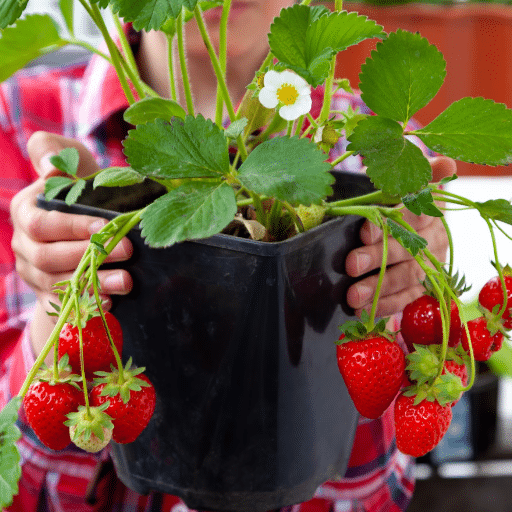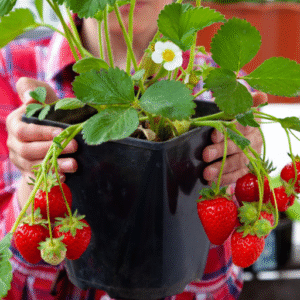Transform your limited gardening space into a strawberry paradise! Growing strawberries in containers is the perfect solution for anyone with space limitations or those looking to add some greenery to their patio, balcony, or small backyard. This comprehensive guide will walk you through everything you need to know to how grow strawberries pots containers of any size.
🏺 Choosing the Right Container for Growing Strawberries

The success of your container strawberry garden starts with selecting the perfect pot. The right container choice significantly impacts your plants’ health and productivity.
Essential Container Requirements
- Size: Minimum 6-8 inches in diameter, with 12-18 inches depth and width being ideal
- Drainage: Multiple drainage holes to prevent waterlogging
- Material: Choose based on your climate and watering habits
- Capacity: Larger containers retain moisture better during hot weather
Best Container Types for Strawberries
| Container Type | Advantages | Best For | Considerations |
|---|---|---|---|
| Fabric Pots | Excellent aeration, prevents overheating, flexible arrangement | Warmer climates, root health | Require more frequent watering |
| Terracotta Pots | Porous material regulates moisture, classic appearance | Consistent watering schedules | Dry out quickly, need regular monitoring |
| Plastic Pots | Lightweight, retain moisture longer, convenient | Hot climates, busy gardeners | Less aeration than other materials |
| Hanging Baskets | Maximize vertical space, beautiful trailing display | Limited space, decorative gardens | Need 6-8 inches depth, coco coir lining |
| Tiered Planters | Multiple plants in compact space, easy harvesting | Small areas, vertical gardening | Ensure each level has proper drainage |
🌱 How to Plant Strawberries in Containers

Proper planting technique sets the foundation for healthy, productive strawberry plants. Follow these step-by-step instructions for best results.
Step-by-Step Planting Process
- Prepare the Container: Ensure adequate drainage holes are present
- Add Quality Soil: Fill with well-draining, organic-rich potting mix enhanced with compost
- Plant at Proper Depth: Position young seedlings with crowns level to soil surface
- Space Appropriately: Allow 6 inches between seedlings for air circulation
- Water Thoroughly: Give plants a good drink after planting
- Position for Sunlight: Place in area receiving 6-8 hours of direct sunlight
Soil and Drainage Requirements
- Soil Mix: High-quality potting mix combined with compost
- Drainage: Well-draining soil that retains some moisture
- pH Level: Slightly acidic soil between pH 5.5 and 6.8
- Organic Matter: Rich in organic material for root development
Proper Spacing and Arrangement
Optimal Plant Spacing:
- Standard spacing: 10-12 inches apart
- Allows proper root spread
- Ensures good air circulation
- Prevents disease development
- In tiered planters: Stagger plants for better sunlight exposure
💧 Care and Maintenance of Container Strawberries

Consistent care is crucial for healthy container strawberries. Here’s your comprehensive maintenance guide.
Watering Guidelines
- Daily Check: Test top inch of soil – water when dry
- Watering Method: Water at base of plant to keep leaves dry
- Hot Weather: May require daily watering
- Mulching: Apply straw or pine needles to retain moisture
- Drainage: Ensure excess water can escape freely
Fertilization Schedule
| Timing | Fertilizer Type | Frequency | Notes |
|---|---|---|---|
| Growing Season | Balanced, water-soluble fertilizer | Every 2-3 weeks | Use fertilizer formulated for fruiting plants |
| Alternative | Slow-release fertilizer | As directed | Provides consistent nutrition |
| Organic Option | Compost or liquid seaweed | Monthly | Promotes healthy growth naturally |
Essential Maintenance Tasks
- Runner Management: Snip runners with sharp scissors to focus energy on fruit production
- Leaf Care: Remove dead, damaged, or yellowing leaves regularly
- Weed Control: Keep soil surface clean of weeds and debris
- Container Rotation: Turn pots occasionally for even sun exposure
- Pest Monitoring: Regular inspection for aphids, spider mites, and other pests
🐛 Managing Pests and Diseases

Prevention and early intervention are key to maintaining healthy container strawberries.
Common Pests and Solutions
| Pest | Signs | Treatment | Prevention |
|---|---|---|---|
| Aphids | Small insects on leaves, sticky honeydew | Insecticidal soap, neem oil | Regular inspection, beneficial insects |
| Spider Mites | Fine webbing, stippled leaves | Increase humidity, neem oil | Avoid dry conditions, proper spacing |
| Slugs | Holes in leaves, slime trails | Remove manually, slug traps | Keep area clean, reduce moisture |
Disease Prevention
- Gray Mold (Botrytis): Ensure good air circulation, avoid overhead watering
- Powdery Mildew: Prevent humid conditions, remove affected leaves promptly
- Root Rot: Maintain proper drainage, avoid overwatering
🍓 Best Strawberry Varieties for Containers

Choose the right variety based on your growing goals and climate conditions.
| Variety Type | Fruiting Pattern | Best Container Varieties | Care Notes |
|---|---|---|---|
| June-bearing | One large crop per year | Traditional varieties | Heavy fertilization after harvest |
| Everbearing | Two crops per year | Ideal for containers | Moderate fertilization throughout season |
| Day-neutral | Continuous production | “Seascape”, “Albion” | Consistent watering, light frequent feeding |
📋 Best Practices Summary
Quick Reference Checklist
- ✅ Container: 12+ inches wide and deep with drainage holes
- ✅ Soil: Well-draining potting mix with compost
- ✅ Sunlight: 6-8 hours of direct sun daily
- ✅ Watering: Consistent moisture, never waterlogged
- ✅ Spacing: 10-12 inches between plants
- ✅ Fertilizer: Balanced, slow-release every 2-3 weeks
- ✅ Maintenance: Remove runners, monitor for pests
🌟 Conclusion
Growing strawberries in containers is a rewarding and accessible way to enjoy fresh, homegrown berries regardless of your available space. With the right container, quality soil, proper care, and attention to detail, you can successfully cultivate a thriving strawberry garden on your patio, balcony, or any sunny spot.
Remember that consistency is key – regular watering, appropriate fertilization, and vigilant pest management will ensure your container strawberries remain healthy and productive throughout the growing season. Start with quality plants, follow these guidelines, and soon you’ll be enjoying sweet, juicy strawberries from your own container garden!
🎯 Success Tip: Start small with 2-3 containers to gain experience, then expand your strawberry container garden as you become more confident with the techniques.
References
- How to Grow Strawberries in Containers | Yard and Garden – Iowa State University Extension and Outreach.
- Growing Strawberries in Containers – Wisconsin Horticulture – University of Wisconsin-Madison Extension.
- Growing Strawberries – Penn State Extension.
Frequently Asked Questions (FAQ)
What types of strawberries can I grow in containers?
When considering which strawberries to grow in containers, the best options are typically everbearing and day-neutral strawberries. Everbearing strawberries produce fruit continuously throughout the growing season, making them ideal for container gardening. Day-neutral strawberries have similar qualities and can produce strawberries even with varying day lengths. These types of strawberries are well-suited for pots due to their compact growth and ability to thrive in limited space. Additionally, you can explore various varieties of strawberries that might perform well in your specific climate.
How do I provide extra insulation for strawberries in containers?
Providing extra insulation for strawberries in containers is essential, especially in colder climates. You can wrap aluminum foil around the pots to reflect sunlight and retain warmth during chilly nights. Additionally, using straw or mulch on top of the soil can help regulate temperature and retain moisture. If you anticipate frost, you can move the pots closer to your home or into a sheltered area. This extra insulation will help your strawberry plants survive winter and thrive next spring.
How do I water strawberries grown in containers?
Watering strawberries grown in containers requires attention due to their limited soil volume. It’s crucial to keep the soil consistently moist but not waterlogged. A good rule of thumb is to check the top inch of soil; if it’s dry, it’s time to water. Ensure your containers have drainage holes to prevent excess water from accumulating. During the hot summer months, you may need to water your strawberries more frequently. Additionally, using a self-watering pot can help maintain moisture levels for your strawberry plants.
What is the best soil for strawberries in pots?
The best soil for strawberries in pots should be well-draining yet retain moisture. A mix of potting soil and compost is ideal, as it provides nutrients and good aeration for the roots. You can also add perlite or vermiculite to improve drainage. It’s important to avoid heavy garden soil, as it can compact in containers and suffocate the roots. Additionally, using a potting mix specifically designed for container gardening can help ensure that your strawberries grow best.
How many strawberry plants can I grow per container?
The number of strawberry plants you can grow per container depends on the size of the pot. For smaller pots, it’s recommended to plant no more than one or three strawberry plants to provide enough space for root growth. In larger gallon pots, you can plant up to 10 strawberry plants, but make sure to consider their growth habits and spacing needs. Each plant requires adequate room to spread and access sunlight. Always check the specific requirements for the types of strawberries you are planting to maximize your yield.






